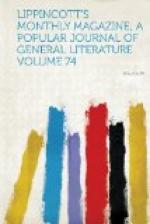“In a very interesting paper read by Professor William R. Nichols of the Massachusetts Institute of Technology before the American Association of Science at its Saratoga meeting in 1879, the results of many analyses of leather bindings were given, showing the presence of the above-named substances in old bindings in many times greater quantity than in new. Still, their presence did not prove them to be the cause of the decay; and Professor Nichols proposes to ascertain the fact by experiments requiring some years for demonstration.
“In the hope of deciding the question with reasonable certainty at once, I have made careful examinations of the books in the three largest libraries of Boston and Cambridge, each differing from the others in age and atmosphere. The bindings of the volumes examined bore their own record in dates and ownership, by which the conditions of their atmosphere in respect to gas and (approximately) to heat were made known for periods varying from current time to over two hundred years. In the Public Library the combined influences of gas, heat and effluvium have wrought upon the leather until many covers were ready to drop to pieces at a touch. The binding showed no more shrinkage than in the other libraries, but in proportion to the time the books had been upon the shelves the decay of the leather was about the same as in the Athenaeum. I am informed that many of the most decayed have from time to time been rebound, so that a full comparison cannot be made between this and the others. In the Athenaeum less gas has been used, and there is very little effluvium,




